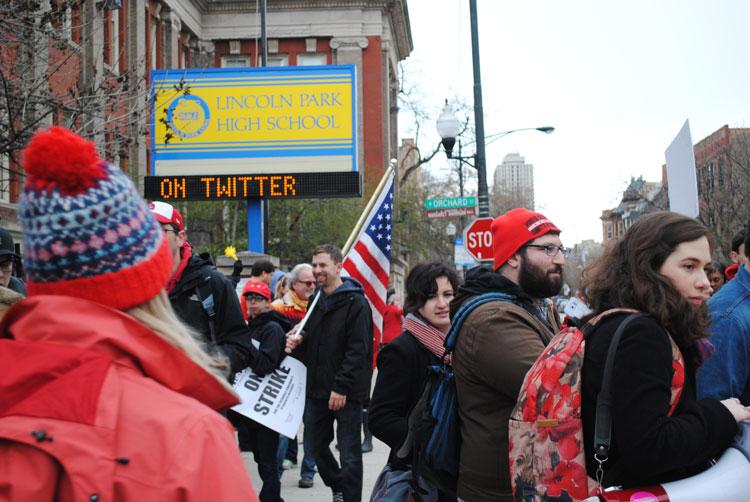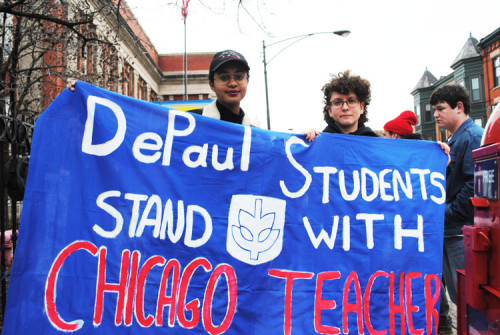
Educators protested peacefully outside Lincoln Park High School in one of many events across the city aimed at attracting the attention of those responsible for the state budget deficit.
“It’s been about 10 months now and we still don’t have a budget. That should be the discussion. We’re here today to highlight the fact that there is still no budget, and schools across Illinois still lack funding. This isn’t a protest about contracts, it’s about helping our schools,” Kevin Krakovsky, the school’s union representative, said.
He said coverage in recent weeks has painted a struggle between North Side schools and South Side schools, as well as suburban districts against Chicago Public Schools.
“The media creates a division approach to deter from the fact that all schools are facing the same issues with funding. This isn’t about North Side schools or South Side schools — it’s about all schools in Illinois,” Krakovsky said.
The protest at Lincoln Park High School was a positive demonstration. People smiled and danced, holding signs depicting Gov. Bruce Rauner as Mr. Burns from “The Simpsons.” The public showed their support with honking and an exchange of thumbs up through the car window and from the sidewalk.
“The media has been divide and conquer,” Anais Donald, a DePaul student, said. “The more divided they make it seem, the more they can divide the schools and people against certain parts of the city, the more they can strike down unions.”
The amount of available funds differs from district to district due to where they receive funding from. Compared to suburban schools, CPS receives more federal funding due to higher enrollment rates of low-income students. Chicago’s public schools receive the majority of funding from property taxes.
This year, other districts received $2,266 per student in pension support from Springfield, while Chicago received $31 per student, meaning that CPS has to come up with the extra money, which, CEO Forrest Claypool has said is “unfair, both to our students and out city’s taxpayers.”

CPS also has a $1.1 billion operating deficit this year.
The teachers and their allies also pointed the finger at City Hall. In addition to Mayor Rahm Emanuel’s closing of nearly 50 schools a few years back, they cited the city’s withholding of Tax-increment-financing (TIF) funds for schools, while they continue to be used to promote development in wealthier areas.
From 2002 to 2010 the TIF program raised $1.69 billion in revenue, of which only 51 percent was invested into public facilities and infrastructure. The remainder went to private businesses.
“The TIF money is supposed to help fix depressed areas in Chicago. What we’re seeing is money going into areas like Randolph and Wabash,” Scott Payne, a Chicago Teachers Union representative, said. “I don’t think the area really needs the money if you take a look at other areas around Chicago.”
Some said the protest is about coming together as a unified group of faculty and students to help address the issue of the underfunding of schools, an issue that stretches beyond public school students and faculty.
“We’re protesting the budget crisis that Illinois and Chicago are going through that currently affects MAP grants, which definitely affects college students, both public and private,” Donald said. “The teachers are doing this because they do put the students first and because the people who go to public schools deserve a good education. You need to make your state responsible for educating your children.”
The legality of the protest was questioned by government officials and used as anti-protest rhetoric from Gov. Bruce Rauner and CPS CEO Forrest Claypool, painting the protest as selfish and as putting themselves first, above the needs of students.
“They have this line our teaching conditions are your students learning conditions, they are intrinsically incorporated into one another,” Hannah Utain-Evans, a DePaul student, said. “It’s also impossible to have a legal strike that gets anything done. Since the ’30s we’ve had a cascade of labor laws passed that keep people from legally striking without any real power behind. So right now teachers can legally strike for contracts that wont be reviewed until May.”

